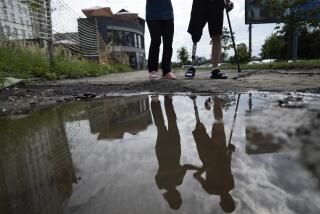In the Race to Save a Limb, There Isn’t Always a Winner
- Share via
HARTFORD, Conn. — Brandy Eddins, 14, lost her forearm in a wood-shop accident on Jan. 11. Later that day, in surgery at Hartford Hospital that went late into the night, Dr. Andy Caputo reattached the forearm, which had been cut midway between wrist and elbow.
The difficult surgery was a technical success, and there was every reason to be optimistic. But when it comes to reattaching upper limbs--”replanting,” in medical jargon--the body has evolved a response that even sophisticated medicine can’t always overcome. Basically, the body does not want to let blood flow to what it considers a wound. Physicians must fight to keep blood from clotting in the replanted part until the blood supply returns to normal.
“The body is trying to repair itself,” Caputo said of the clotting. “We’re telling it not to.”
In Brandy’s case, the replant did not take. Ten days after surgery, the Meriden, Conn., girl’s forearm had to be removed.
Although Americans have become accustomed to medical miracles, successfully reattaching arms, hands and fingers is part skill and part luck. The kind of amputation and the location of the cut are huge factors, as are the condition of the patient, the condition of the severed part and the speed with which both get into the operating room.
Caputo, co-director of the hand surgery service at Hartford Hospital and Connecticut Children’s Medical Center, said the success rate for fingers is about 80%, but it drops to about 60% for forearm amputations and drops further as amputations get closer to the shoulder. The more muscle involved, the harder it is to reestablish blood flow and nerve connections and avoid infection.
After an amputation, physicians first determine whether the severed upper limb can be replanted. The cleaner the cut, the better. Ideally, the severed part has been transported in saline-soaked gauze, in a plastic bag, floating in ice, which helps the part stay vital longer.
Several early steps must be taken quickly.
Both sides of the sections that will be joined must be cleaned, and dead tissue must be cut back to help prevent infection. Fresh blood needs to be supplied to the amputated limb as soon as possible. If the forearm bones--the radius and ulna--can be quickly reconnected using screws and plates, this can be done before the ulnar and radial arteries, which feed the hand, are re-linked. Otherwise a tube or shunt may be used to infuse the severed part with fresh blood.
What follows is the methodical reconnection of the vessels and structures that provide blood, function and feeling to the replanted hand or forearm. Such reconnections were first made possible in the 1960s by the introduction of the operating microscope and the development of ultra-fine suture materials and needles. Although the materials make it possible, there is no shortcut. Once the arteries are connected, four veins must be linked for the outflow of blood. In Brandy’s case, Caputo said repairing the veins and arteries took about half an hour each.
The surgeon typically works from the deepest vessels to the surface, connecting tendons that cross near repaired blood vessels so that certain areas can be closed off quickly. Twenty-five tendons cross the wrist, said Caputo, but depending on the injury, some may not be repairable. Nerves in the forearm also are re-linked using microsurgery.
Depending on the nature of the injury, the skin is sutured at the end of the replant. The surgery is done, but the clock is still ticking as doctors try to prevent clotting.
Throughout the procedure and during recovery, the patient is given blood-thinning drugs. Caputo said that anything that causes blood vessels to constrict has to be avoided, so patients are kept warm, shielded from any source of excitement or worry and prevented from consuming chocolate or caffeine. There is a ban on cigarette smoking, which has been shown to significantly lower chances for success.
In the hours and days after surgery, the medical staffers watch for signs that blood flow is returning to the replanted limb. They gently press on the replanted hand or finger to see how fast its pink color returns--a sign that the blood supply is adequate. Withered, wrinkled fingertips are a sign that arterial blood is blocked. Doctors can reopen the site and redo the joining of the artery, but Caputo said that the success rate drops dramatically if this is attempted more than 24 hours after the original reconnection.
Areas of purplish swelling suggest blocked veins. Physicians may loosen some of the sutures to relieve pressure and improve blood flow. If that doesn’t work, 2-inch-long leeches may be applied--a return to a once-discredited medical practice. As the leeches bite, they inject the area with a natural blood-thinning chemical. Blood is able to flow from the bite wounds for hours without clotting, taking pressure off the area and allowing new circulation to be created. Multiple leeches may be used for days.
*
Garret Condon writes for the Hartford Courant, a Tribune company.
More to Read
Sign up for Essential California
The most important California stories and recommendations in your inbox every morning.
You may occasionally receive promotional content from the Los Angeles Times.










